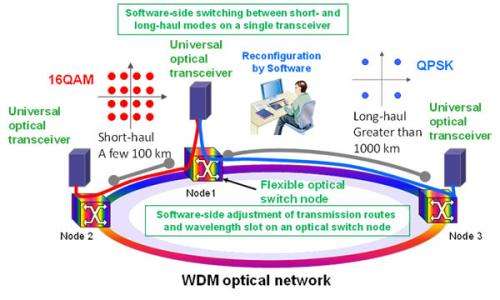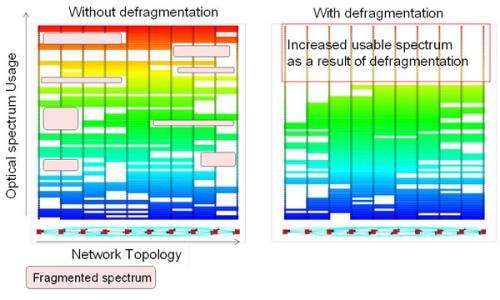Fujitsu develops technology to increase efficiency of in-service optical network resources

Fujitsu today announced the development of the world's first technology for future long-haul and metropolitan optical networks that can dynamically alter the architecture of optical network resources and enhance utilization efficiency without disrupting service.
As a result of the spread of data-centric cloud services, smartphones and other technologies in recent years, a wide variety of network-enabled services are now being offered. At the same time, for the core networks supporting these services, it is important to be able to shorten the time required to bring online new optical circuits that deliver on-demand services, as well as to increase transmission capacity while reducing the energy consumption of network devices. In light of this, Fujitsu has developed two technologies: "flexible optical node" technology that overcomes limitations in terms of optical signal wavelength, modulation scheme and routes; and "spectrum defragmentation technology," which leverages flexible optical nodes to increase the utilization efficiency of in-service optical network resources. This, in turn, makes it possible to improve optical network transmission capacity by up to 40%.
Using the new technology, optical network architecture can be flexibly altered as needed, and given the improvement in the utilization efficiency of network resources, it is possible to shorten the time required to launch new optical circuits, while cutting power consumption by eliminating unnecessary network devices. Fujitsu will work to standardize 400 Gbps-class next-generation interfaces while developing hardware and pursuing R&D on network management systems in aiming to commercialize the new technology.
With respect to optical switch nodes, communications bandwidth can be adjusted, and through optical switch technology that enables the selection of multiple communications routes, it is possible to perform software-side configuration of communications routes. Combining these routes enables a single optical switch node to be shared among multiple users, flexible configuration to meet users' needs, and realization of flexible optical nodes that can be configured
The digital signal processing LSI employed to test the effectiveness of the new technology was developed as part of Japan's Ministry of Internal Affairs and Communications (MIC)'s project for "R&D on Ultra-High-Speed Optical Transmission Technology."
The following challenges are evident in bringing about the next generation of high-capacity and flexible optical networks.
Limitations to the usable spectrum and communications routes of optical networks
Due to the limitations of optical components and electronic components used inside current optical switch nodes and optical transceivers, it is not possible to freely configure the optical wavelengths, bandwidth, modulation schemes and communications routes employed for communications. As a result, to bring new optical circuits into operation, cables have to be manually rerouted and new equipment deployed.
Diminished optical wavelength utilization efficiency as a result of in-service adjustments to communications routes
As a result of constantly adjusting optical spectrum routes while a network is in use, fragmentation can occur in the assignment of optical signals that were initially allocated to optimize network utilization efficiency. This spectrum fragmentation makes it impossible to allocate optical fiber communications routes and bandwidth, a process that is necessary to launch new optical circuits, thereby diminishing the utilization efficiency of transmission equipment.

Using the new technology, optical network architecture can be flexibly altered as needed, and given the improvement in the utilization efficiency of network resources, it is possible to accelerate bringing online new optical circuits while reducing power consumption by eliminating unnecessary network devices.
Flexible optical node (optical transceivers, optical switches) capable of software-side adjustments to network architecture
Using digital signal processing technology, Fujitsu developed a "universal transceiver" architecture that makes it possible to make software-side adjustments to the transmission schemes of optical transceivers. To accommodate long-haul users, the nodes can be configured to a relatively wide-band transmission scheme employing a highly noise-tolerant modulation scheme that is suitable for long-haul transmissions. For short-haul users, the nodes can be configured to a transmission scheme that is suitable for short-haul transmissions and features high frequency utilization efficiency, but is not very noise tolerant.
Improved utilization efficiency of in-service spectrum resources through spectrum defragmentation
Fujitsu has developed a network control mechanism that employs a defragmentation algorithm for securing usable bandwidth allocable for high-volume data by consolidating fragmented spectrum into an uninterrupted spectrum continuum. Using a flexible optical node device architecture, fragmented optical spectrum resources are continuously consolidated into a wavelength band of a size that is allocable for 400 Gbps-class wide-band signal, all while the network remains in service. By channeling the resulting wavelength band into properly configured optical signals, it is possible to improve the utilization efficiency of spectrum resources.
In an experimental network environment featuring four optical switch nodes, Fujitsu demonstrated—for the first time in the world—the use of defragmentation technology employing digital signal processing technology to shift a 100Gbps DP-QPSK optical signal without disrupting service. By taking advantage of the signal bandwidth made available through the defragmentation process, optical network communications capacity can be improved by 40%.
The new technology will be announced at the European Conference on Optical Communications (ECOC) 2012, to be held in Amsterdam from September 16 - 20.
Provided by Fujitsu


















